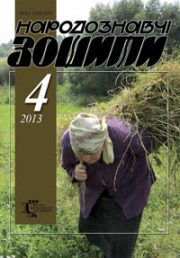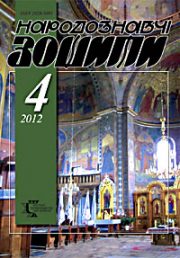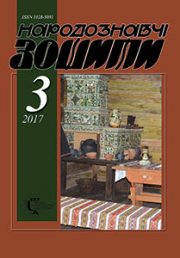The Ethnology Notebooks. 2022. № 4 (166), 798—813
UDK 391+677.076.62(477)
DOI https://doi.org/10.15407/nz2022.04.798
BALUSHOK Vasyl
- ORCID ID: https://orcid.org/0000-0003-1362-8270
- PhD in History, Senior Research Fellow,
- Maksym Rylskyi Institute of Art Studies,
- Folklore Studies and Ethnology,
- National Academy of Sciences of Ukraine,
- 4, Hrushevskoho str., 01001, Kyiv, Ukraine,
- Contacts: e-mail: grigras@i.ua
OLIYNYK Maryna
- ORCID ID: https://orcid.org/0000-0002-2946-8243
- PhD in History, Research Fellow,
- Maksym Rylskyi Institute of Art Studies,
- Folklore Studies and Ethnology,
- National Academy of Sciences of Ukraine,
- 4, Hrushevskoho str., 01001, Kyiv, Ukraine,
- Contacts: e-mail: marina.oliynik@gmail.com
Abstract. Introduction. As of today, there is no clear chronological chain of sources about the Ukrainian embroidery on clothes in the Kyivan Rus’ until the XVIIth century, and for commoners until the XVIIIth century, thus supporting the arguments of post-modern sceptics about its later existence. The goal of this article is to study, according to the source status, the problem of durability of the given embroidery from the period of the Kyivan Rus’ till the end of the XVIIIth — beginning of the ХІХth centuries when it was in focus of professional interests for folk culture researches. We have studied archaeological, iconographic, and written sources. The methodology has been created by F. Boas, A. Kreber, K. Hrushevska, M. Salins, S. Arutiunov in the provisions on the laws of evolution and common impact of various cultures, and also on the functionality of cultural phenomenon, including the mechanism of adoption and interaction of borrowed and autochthonous culture components.
Results. The significant spread of embroidery on clothes of various social classes in the Ancient Rus’ is evidence, first of all, by iconographic and, especially, archaeological materials received in course of numerous excavations. A lot of remains with the signs of embroidery on linen, woolen and silk clothing made with linen, silk and, especially, gold threads has been preserved. The remains of gold sewing in most cases belonged to the representatives of the boyar elite, however, they were also found in the burials of commoners. The use of embroidery on clothes in the Ancient Rus is also evidenced by a fewer, but certain written sources, first of all, by the Galician-Volhynian Chronicle. Unfortunately, in the late medieval-early modern period, for the ideological reasons the archaeological research of Ukraine was not carried out, and written sources reflected a small number of facts on embroidery on clothes of the Ukrainians. However, we can find some facts in the testimonies of the European adventurers who visited the Kyivan Rus’ in the XV—XVIIth centuries: Hilbert de Lannoy, Huillaume Levasseur de Beauplan, Conrad Jacob Hildebrandt, Ulrich von Werdum. The use of embroidery on clothes in Ukraine in the XVІ—XVIIІth centuries is also preserved on icons, numerous records and other sources published in the sets of documents and various publications (Lithuanian Metrica, materials of court cases, wills, etc.). Finally, records and drawings of «topographic» descriptions of authors of the end of the XVIIIth century — beginning of the ХІХth century (Mykhailo Antonovskyi, Oleksander Rihelman, Afanasii Shafonskyi, Yezhy (Yurii) Hlohovskyi) also include traditional culture of the Ukrainians, evidence of the use of the Ukrainian embroidery on clothes. Conclusion. The sources evidence that the Ukrainian embroidery on clothes, which originated even before the Kyivan Rus, existed, changing and enriching due to the adopted foreign cultural borrowings, until modern period. In the course of modern forming of the nation it became the basis for the formation of a new tradition (according to E. Hobsbawm and T. Ranger).
Keywords: embroidery, Ancient Rus’, Middle Ages, early modern period, sources.
Received 2.08.2022
REFERENСES
- Balushok, V., & Oliynyk, M. (2021). Аn embroidery on clothes of Ukrainians: some problems of contemporary discourse. The ethnology notebooks, 4, 847—861 [in Ukrainian].
- Balushok, V., & Oliynyk, M. (2021). Embroidery on Ukrainian clothes: the problem of origins. The ethnology notebooks, 5, 1150—1166 [in Ukrainian].
- Kosacheva, O. (1876). Ukrainian Folk Ornament. Embroidery, Fabrics, Pysanky. Kiev: S.V. Kulzhenko [in Russian].
- Miller, A., Uvarova, P.S. (Ed.). (1911). Lotus in Little Russian Ornament. Proceedings of the IV Archaeological Congress in Chernigov (Vol. ІІІ, pр. 81—88). Moscow [in Russian].
- Savitsky, P. (1914, June 13—20). About Ukrainian Embroidery of the XVIIIth Century and its modern Revival. Chernihiv Zemstvo Week, 24, 1—5; 25, 1—5 [in Russian].
- Modzalevs’kyj, V. (1918). The main Features of Ukrainian Art. Chernihiv [in Ukrainian].
- Spaska, E., & Skripnik, H. (Ed.). (2015). Ethnographic and Art Studies. Kyiv [in Ukrainian].
- Novyts’ka, M.O. (1965). Gold Embroidery in Kyivan Rus’ (According to Excavations in the USSR). Archeology (Vol. XVIII, pp. 24—38) [in Ukrainian].
- Rabinovich, M.G. (Ed.). (1986). Old Russian Clothing of the IXth—XIIIth Centuries. Ancient Clothing of the Peoples of Eastern Europe. Materials for the Historical and Ethnographic Atlas (Рр. 40—62). Moscow [in Russian].
- Zakharchuk-Chugai, R.V. (1988). Ukrainian folk embroidery: western regions of the Ukrainian SSR. Lviv: Naukova dumka [in Ukrainian].
- Tyshchenko, O.R. (1992). History of decorative and applied Art of Ukraine (XIII—XVIII centuries): Teaching manual. Kyiv: Lybid [in Ukrainian].
- Fechner, M.V., & Nedoshivina, N.G. (Ed.). (1993). Old Russian Gold Embroidery X—XIII Centuries in the Collection of the State Historical Museum. Medieval antiquities of Eastern Europe (Рр. 3—21). Moscow [in Russian].
- Mihajlov, K. (2007). Early examples of Old Russian Gold Embroidery from Chernigov and Shestovitsa. Chernihov in the medieval and early modern History of Central and Eastern Europe. Collection of scientific Works dedicated to the 1100th anniversary of the first chronicle mention of Chernihiv (Рр. 138—153). Chernihiv [in Russian].
- Kara-Vasyl’ieva, T. (2008). History of Ukrainian Embroidery. Kyiv [in Ukrainian].
- Brajchevs’ka, O., & Skripnik, H. (2010). Weaving, Embroidery. History of Ukrainian Art: in 5 vols. Art of the Middle Ages (Vol. 2, pp. 808—1193). Kyiv [in Ukrainian].
- Zaichenko, V. (2015). Embroidery of a Cossack Sergeant of the XVII—XVIII Сenturies from the Collection of the Chernihiv Historical Museum named after V.V. Tarnovsky. Kyiv [in Ukrainian].
- Adruh, A. (2020). Embroidery and Gold Embroidery of Chernihiv in the second half of the XVII — early XVIII Centuries. Severyansky chronicle, 1, 36—51 [in Ukrainian].
- Balushok, V. (2018). From the History of Ukrainian Ethnonymy (from «Ruthenians» to «Ukrainians»). Ukrainian Historical Journal, 2 (539), 163—178 [in Ukrainian].
- Linnus, H. (1955). Embroidery in Estonian Folk Art. Northern Estonia and the islands (Vol. 1). Tallinn [in Russian and Estonian].
- Hobsbawm, E., & Ranger, T.(Ed.). (2010). The invention of tradition. 2nd kind. Kyiv: Nika-Center [in Ukrainian].
- Saburova, M.A. (1975). On women’s Headdresses with a rigid Base in the Monuments of pre-Mongol Rus’. Brief Reports of the Institute of Archaeology (Vol. 144, pp. 18—22) [in Russian].
- Sveshnikov, I.K., & Braichevska, O.A. (1990). Leather Shoes from Zvenyhorod Halytsky. Archeology, 3, 122—129 [in Ukrainian].
- Ivakin, V.G. (2008). Christian burial Monuments of Kyiv of Ancient Rus’. Kyiv [in Ukrainian].
- Shakhmatov, А.А. (Ed.). (1908). Complete Collection of Russian Chronicles. The Ipatiev Chronicle (Vol. 2). St. Petersburg [in Russian].
- Lannoy, G.de. (1840). Voyages and Embassies of Messire Guillebert de Lannoy, 1399—1450. Mons [in French].
- Boplan, G.L. de., Kravets, J.I., & Borisyuk, Z.P. (1990). Description of Ukraine. Kyiv [in Ukrainian and French].
- Olyanchyn, D., & Krypyakevych, I. (Ed.). (1937). Description of the Swedish Ambassador’s Trip to Ukraine in 1656—1657. Notes of the Shevchenko Scientific Society. Works of the historical and philosophical Section (Vol. CLIV, pp. 39—69). Lviv [in Ukrainian].
- Werdum, U. von. (1786). Ulrich von Werdum‘s (1670—1677) Travel Journal. Archive on Modern History, Geography, Knowledge of Nature and People: With coppers by Jean Bernoulli. Leipzig [in German].
- (1883). Archive of Southwest Russia (Part 1, vol. 6). Kiev [in Russian].
- Bojchuk, M.K. (Ed.) (1965). Act Book of the Zhytomyr City Service of the late XVI Century. Kyiv [in Ukrainian].
- Mojsijenko, V.M. (Ed.) (2004). Acts of the Zhytomyr Castle Service: 1590, 1635. Zhytomyr [in Ukrainian].
- Georgi, I.G. (1799). Description of all Peoples living in the Russian State. Their everyday Rituals, Customs, Clothes, Dwellings, Exercises, Fun, Religions and other Attractions. St. Petersburg. [in Russian].
- Rigelman, O.I., Sas, P.M., & Scherbak, V.O. (Eds.). (1994). Chronicle of Little Russia and its people and the Cossacks in general. Kyiv: Lybid [in Russian, in Ukrainian].
- Shafonsky, A. (1851). Chernigov Governorship Topographic Description with a brief Geographical and Historical Description of Little Russia. Kiev [in Russian].
- Krvavich, D.P., & Stelmashchuk, H.H. (Eds.) (1988). Ukrainian Folk Clothing XVII — early XIX Сenturies in Watercolors by Yu. Hlogovsky. Kyiv [in Ukrainian].
- Boas, F. (1927). Primitive Art. Oslo; Harv. Univ. Press.
- Kroeber, A.L. (1952). The Nature of Culture. Chicago.
- Sahlins, М.D., Manners, R.A., & Kaplan, D. (Eds.). (2009). Evolution: specific and general, Anthropological Theory: a Sourcebook (Pp. 229—241). New Brunswick and Lindon.
- Arutiunov, S.A. (1989). Peoples and Cultures: their Development and Interaction. Moscow [in Russian].
- Shevchuk, T., & Stavytska, J. (2017). Ukrainian oral Dream interpretation Tradition of the early twentieth Century (Intelligence and Texts). Kyiv [in Ukrainian].
- Hrushevska, K. (1929). On the side Paths of the Kobzar Epic («Duma about the Shepherd» — the Addition for the Question of Parodies of Kobzar Dumas). Primitive Citizenship and its Remnants in Ukraine, 2, 13—50 [in Ukrainian].
- Hrushevska, K. (Ed.). (1927). Collection and Publication of Dumas in the XIX and early XX Centuries. Ukrainian People’s Dumas: in 2 vols. (Vol. 1, pp. ХІІІ—ССХХ) [in Ukrainian].
- Hrushevska, K. (1928). Two centers of ethnological science. (From travel experiences). Primitive Citizenship and its Remnants in Ukraine, 2—3, 81—96 [in Ukrainian].
- Hrushevska, K. (1928). [Review] С.G. Seligman. The unconscious in relation to anthropology. The British Journal of Psychology, v. XTII, april 1928. Citizenship and its Remnants in Ukraine, 2—3, 169—171 [in Ukrainian].
- Vovk, Khv., & Skripnik, H. (Ed.). (2012). Characteristic Features of South Russian Folk Ornaments. Ethnographic Heritage of Khvedir Vovk (Vol. 1, pр. 108—116). Kyiv [in Ukrainian].
- Niederle, L. (1924). Life and Culture of the Ancient Slavs. Prague [in Russian].
- Klochko, L., & Strokova, L. (2006). Fabrics in Kyivan Rus’ (based on the Collection of the National Museum of History of Ukraine). Sights of Ukraine, 3, 12—17 [in Ukrainian].
- Stepanova, Yu.V., Elkina, I.I., & Wagner, M. (2019). Embroidery in Old Russian Costume of the 11th—13th Centuries: Place, Meaning, Ornament. The Art of Аncient Textiles. Study Methods, Preservation, Reconstruction. Proceedings of the Russian-German Seminar (Moscow, March 11—13, 2018) (Pp. 270—289). Moscow [in Russian].
- Latyshev, V.V. (1948). Proceedings of ancient Writers about Scythia and the Caucasus. Greek Writers. Bulletin of Ancient History, 4, 225—298 [in Russian].
- Saburova, M. L. Funeral Headdress with Christian Symbols from Female Burials of the XII—XIII Centuries. Retrieved from: https://museum-murom.ru/scientific-work/materialy-konferencij-muzeya/konferenciya-uvarovskie-chteniya/uvarovskie-chteniya-ii/m.-l.-saburova.-pogrebalnyj-golovnoj-ubor-s-hristianskoj-simvolikoj-iz-zhenskih-pogrebenij-xii-xiii-vv (Last accessed: 03.11.2020) [in Russian].
- Saburova, M.A., Kolchin, B.A., & Makarova, T.I. (Eds.). (1997). Clothes. Ancient Rus‘. Life and Culture (Рp. 93—102). Moscow [in Russian].
- Sagaidak, M., Ivakin, V., & Taranenko, S., Borisenko, M. (Ed.). (2016). Sacral zones of the south-eastern Kyiv-Podil (XI—XIII centuries). City: history, culture, society. Electronic Journal of Urban Studies (Pp. 106—128). Kyiv: Institute of History of Ukraine, National Academy of Sciences of Ukraine; Faculty of History; Kyiv National University named after Taras Shevchenko [in Ukrainian].
- Saburova, M.A., Kolchin, B.A., & Makarova, T.I. (Eds.). (1997). Footwear. Ancient Rus’. Life and Culture (Рp. 103—105). Moscow [in Russian].
- Hensel, W. (1967). Poland a Thousand Years Ago (Issue 3). Wroclaw; Warsaw; Krakow [in Polish].
- Tatishchev, V. N. (1773). History of Russia since the most ancient times (Part 2). Printed at the Imperial Moscow University [in Russian].
- Tolochko, A. (2005). «Russian History» by Vasily Tatishchev: Sources and News. Moscow; Kiev [in Russian].
- Kosmina, O.Ju. (2011, june 27—30). Ukrainian Shirt: from Linen to ethnic Symbol. Fashion and Design: historical Experience — new Technologies. Materials of the XIV th International Scientific Conference. St. Petersburg, June 27—30, 2011 (Pр. 370—373). St. Petersburg [in Russian].
- Mrs. Archibald H. Christie.(1906). The Artistic Crafts Series of technical Handbooks: Embroidery and Tapestry Weaving. New York; London.
- Mishanich, O.V., & Makhnovets, L.E. (Ed.). (1989). Chronicle of Rus’. Kyiv [in Ukrainian].
- Onohda, O.V., Chekanovsky, A.A., & Chmil, L.V. (2010). Results, Problems and Prospects of Studying the Ceramics of the Middle Dnieper Region of the Second Half of the XIII — XVIII Centuries. Archeology and Ancient History of Ukraine: Collection of Scientific Works (Vol. 1, pp. 446—453). Kyiv [in Ukrainian].
- Emelyanov, V. (1873). Travels of Hillbert de Lannoa to the Eastern Lands of Europe in 1413—1414 and 1421. University News, 8, 1—46 [in Russian].
- Brun, F.K. (1853). Travels and Еmbassies of Mr. Gillbert de Lannoy, Knight of the Golden Fleece, Owner of Santa, Villerval, Tronschien, Beaumont, Wagenie; in the Years 1399—1550. Notes of the Odessa Society for the History of Antiquities (Vol. 3, pp. 433—465). Odessa [in Russian].
- Cherkasov, D.N. (2015). Gilbert de Lannoy and his «Voyages et ambassades». Studies in the History of Eastern Europe. Scientific collection (Vol. 8, pp. 195—241). Minsk [in Russian].
- Isaievych, Ya. (1996). Ukraine, old and new: People, Religion, Culture. L’viv [in Ukrainian].
- Blok, M., & Lysenko, E.M. (1986). Feudal Society. Blok M. Apology of History or the Craft of a Historian (Рp. 122—181). Moscow [in Russian].
- Starchenko, N. (1998). Publicity as a Dominant Cultural Tradition (Volyn of the Second Half of the XVI Century). Mediaevalia Ukrainica: Mentality and History of Ideas (Vol. V, pp. 68—81). Kyiv [in Ukrainian].
- Moіsienko, V.M., & Polishhuk, V.V. (Ed.). (2013). Lutsk Castle Book of 1560—1561. Lutsk [in Ukrainian].
- Voitiv, G.V. (1995). Names of Clothes in the Monuments of the Ukrainian Language of the XIV—XVIII Centuries. Abstract Dis. … Candidate of Philological Sciences. Lviv [in Ukrainian].
- Sreznevskij, I. (1912). Materials for the Dictionary of Language of Ancient Rus’ on the written Monuments of I. Sreznevsky (Vol. 3: R—Ja and Additions). St. Petersburg [in Russian].
- (1903). Lithuanian Metric. The first Book of Court Cases. Russian Historical Library (Vol. 20). St. Petersburg [in Russian].
- Werdum, U. von., & Svarnik, I. (1989). Diary of a Trip, I made in 1670, 1671, 1672… through the Kingdom of Poland… Zhovten’, 9 (467), 87—99 [in Ukrainian].
- Janisz, M. Painted with needle and thread. The history of embroidery in outline. Retrieved from: https://docplayer.pl/6424221-Igla-i-nicia-malowane-historia-haftu-w-zarysie.html (Last accessed: 08.07.2021) [in Polish].
- Olearius, А., & Barsov, P. (1870). A detailed Description of the Journey of the Holstein Embassy to Muscovy and Persia in 1633, 1636 and 1639, compiled by the Secretary of the Embassy, Adam Olearius. Moscow [in Russian].







